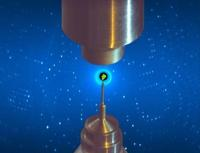Speaker
Description
Chlorite dismutases (Clds), are heme b-dependent oxidoreductases that are catalysing the degradation of toxic chlorite to harmless chloride and molecular oxygen. This catalytic function turns Clds into interesting enzymes for bioremediation. The enzyme CCld (from Cyanothece sp. PCC7425) was studied extensively with regard to its biochemical and biophysical properties and represents a perfectly suited model for mechanistic studies. It exhibits the Cld-typical pH-dependent chlorite degradation activity and becomes irreversibly inactivated at basic pH. This was thought to be due to the presence of a conserved arginine residue in close proximity to the heme. Literature proposes that this amino acid residue possesses a shifted pKa value of the side chain, thereby being mainly deprotonated above pH 7 which correlates very well with the enzyme’s activity profile. However, results obtained from neutron crystallography experiments with hydrogenated CCld crystals, after hydrogen/deuterium exchange, showed a still protonated arginine even at pD 9.4. To prove the obtained data and expand our knowledge, the planned neutron crystallography experiments with perdeuterated CCld crystals are expected to give more detailed informations on the protonation state of potentially turnover associated amino acid residues. Neutron cryo-crystallography should be performed to catch short-lived reaction intermediates of CCld. The results are highly important for interpretation of mechanistic data of CCld.

